Cardboard Children: Descent - Legends Of The Dark
An ambitious, hybrid board game that blends the physical and digital with fantastic results
Hello youse. My name is Rab Florence, and for six years I would land my jetpack here on RPS every week to tell all of you PC gamers about board games. Four years ago my jetpack exploded, separating my head from my body and traumatising the spectators below, meaning that I had to retire my column on account of me having, well, nae heid. But I have returned from the cardboard grave to regale you with a tale of high adventure in Descent: Legends of the Dark.
I thought this new board game would be a perfect thing to talk to you all about, because it's not really a board game at all. Well, it is. But you can't play it without using an app, on your phone or your tablet or – yes – your actual PC! So it's actually a PC game! With a board. Because it’s a board game. Except it isn't. Apart from when it is.
First, let me take your hand – don't worry, I've recently sanitised and I'm double vaccinated – so that I can lead you back in time. I’m talking back before Prince died, an event that would send the universe rattling onto the darkest timeline. It was 2006, and I'd just played a board game called Descent: Journeys in the Dark.
The first edition of Descent was a great game, and an absolute shambles. The rulebook was a disaster. It took ages to play, caused arguments with your friends over rules issues, and loaded you up with enough fiddly cardboard tokens to choke that weird horse you met in Soho who likes getting choked. It was deeply unfriendly, with one person playing as the evil Overlord and the others controlling a band of heroes who would grow to absolutely detest the power the Overlord wielded – the power to keep you up until three in the morning by spawning twenty kobolds in front of every exit. And yet, the game felt huge, epic and sprawling. It created thrilling moments. It was, in its own way, a triumph.
The second edition of Descent came when the fashion was for streamlining games. In the early going, this new edition was a delight and a revelation. So many of the old frustrations had been smoothed into a light and delicious powder like Banana Nesquik or – if I was writing this for Vice – Cocaine. But, in time, Second Edition proved to be a bit of a bust. The game mechanics, so friendly and frictionless, combined with bland scenario design to produce a game that felt less like a thrilling adventure and more like a weird optimisation race.
Which brings us to now. A new Descent game that is not only a complete reimagining of what Descent is, but a reimagining of what a tabletop game can be.
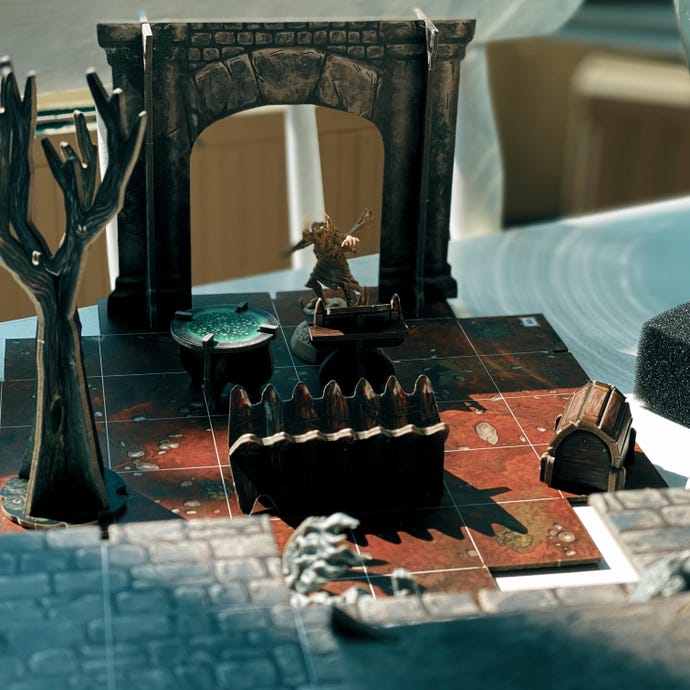
Inside the box there are forty plastic miniatures representing the hero characters and the monsters they will meet along the way. Standard stuff. Also in the box you'll find a stack of floor tiles, some cards representing weapons, skills and the like, and an IKEA trolley load of cardboard furniture.
This cardboard scenery and furniture has been a big selling point of this deeply weird game. “Play with your PLASTIC SOLDIERS by moving them around these crappy CARDBOARD TREES,” they've been shouting, like they're drunk. And they must be, because this game makes no conventional sense.
I'm a huge fan of a UK company called Battle Systems – they make best in class cardboard scenery and terrain – and the stuff in this new Descent doesn't come anywhere close. It's a kinda tacky and cheap introduction to the game, because assembling that daft-looking cardboard tree is one of the first things you do. It's a big red flag. A big cardboard red flag you have to slot together yourself.

Then you get to loading up the app. I used my phone to do this for my initial run at the campaign, but that was mainly for convenience. I strongly recommend using the version you can download from the software delivery service known as Steam, which you'll find somewhere on Ask Jeeves. The app starts, invites you to start a campaign, and then sits you down to tell you a story.
The Descent games are set in a place called Terrinoth. It is one of the most supported fantasy realms in the history of gaming, and is about as exciting as having a lie down because you feel a bit sad about capitalism. It's the ultimate generic fantasy land, and as the app starts blabbering on at you about DARKNESS RISING IN THE NORTH and stuff, it's almost enough to make you ram a cardboard tree into your own eye. However –
The art helps. From the moment this game was revealed, people have been moaning about how “weird and gangly” the characters look. “Look at the size of her stupid helmet!” they've been bellowing, crumbs of Oreo spraying all over their divorce papers. “Is that dwarf a black woman?”, they've gasped, leaning on their pile of unopened Kickstarter pledges for support as their spindly legs wobble on the precipice of self-realisation.
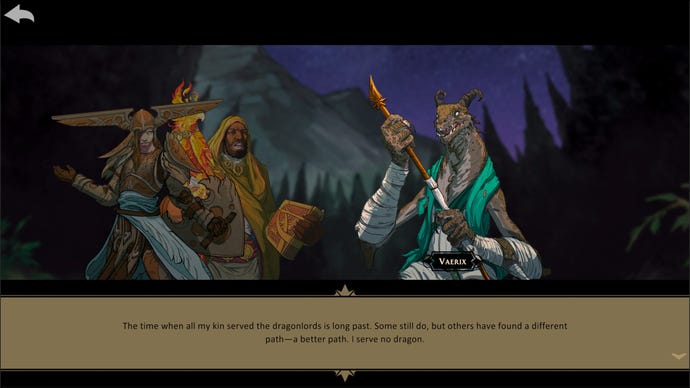
They’re wrong. The art is great. Legends of the Dark has something that every other edition of Descent has lacked – character. The increased level of diversity has helped on that front. These heroes feel more like the inhabitants of a real world than any of the dozens of characters from previous editions ever did.
And then the app issues a command: Pick a couple of these heroic weirdos, tool them up with some cards, then lay out a couple of tiles and a tree or two.
Visualise this now: on your computer screen, there's a representation of what's on your table. A floor tile or two. A couple of cardboard trees. A couple of tokens that can be interacted with. Your heroes only appear on your table, however. All of that stuff – the traditional board game stuff of choosing your actions and moving your piece and rolling your dice – that's on the table and in your hands. But whenever you take a key action, like interacting with something or attacking an enemy, you have to let the app know.
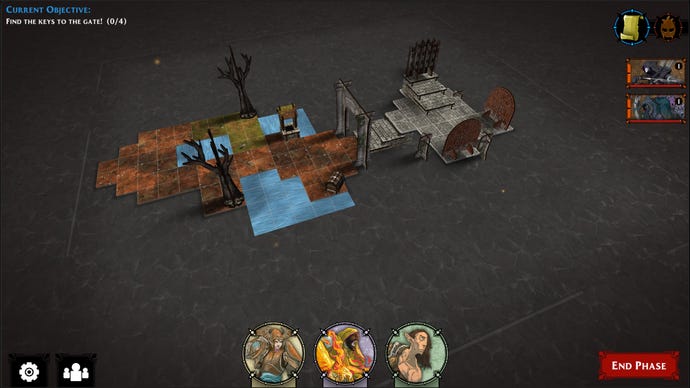
And here's why. Those crappy cardboard trees I mentioned earlier? They aren't crappy at all. They're actually beautiful, significant objects in the history of gaming. You can move your plastic hero, on your table, up to a cardboard tree – and then you can forage from it. You tell the app your hero has interacted with the tree (with a simple drag and point on the screen) and then a handful of mushrooms and herbs spring into your party's inventory. You don't have to flip a card, or take twenty tokens, or write anything down. You just did it, and now you have it. Maybe it doesn't sound like much, but it feels magical when it happens. It feels like there’s some benevolent Dungeon Master sitting at your table, saying, “Have fun, I'll keep track of everything.” And further than that, it feels like the stuff at your table is alive.
Man, the fights! The app tells you where to spawn the enemies, and then runs the AI by giving you simple instructions. You're told what the monsters can do, any special abilities they have, and who they particularly hate this round. All this information about the monsters is within the app. There's no monster statistics card for you to study and analyse. It all happens organically and on the hoof, and so you’re not thinking of the enemies as little mini-puzzles. You're thinking moment to moment, and it feels like an actual fight. Sometimes the app will tell you something like “The Zealot utters Brynn's name under its breath!” And it's a little storytelling moment, a character moment that lets you know that things are about to go south real quick for ol' Brynn if the team doesn't get their shit together quickly. The fights too are alive.
The hardest thing to keep alive in any dungeon delving board game is a sense of mystery. Most games show their hand right at the start. It's all BUILD THESE ROOMS, PLACE THESE CHESTS, SPAWN THESE SKELETONS, HAVE AT IT. You usually know how big the area is, and where all the cool stuff is hiding. The First Edition of Descent had you build the dungeon area by area as doors were opened. But that job had to fall to one of the players, and the surprises that a system like that could produce were few.
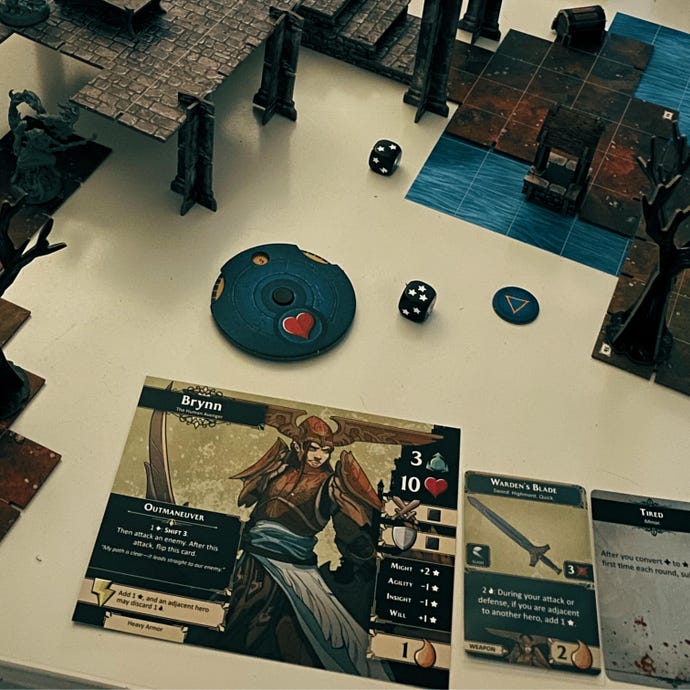
Legends of the Dark, however, uses the app to unfold the dungeons. Sure, you still have to set stuff up as you play, but nobody at the table knows what the hell is going to happen next, or how big the dungeon is going to be, or how weird things are going to get. It's a genuine thrill to arrive at a door and have your hero turn the handle. Because –
Forget setting. Forget story. Because, my goodness, the scenario design in this game is fantastic. The app has afforded the designers a huge amount of creative freedom in how a mission can play out. I find that Legends of the Dark feels like it's in the same kind of imaginative space as those old Fighting Fantasy game books that I love so much. This game is full of strange encounters and surprise turns of events. On numerous occasions I sat back all wide eyed and thought “Wow. That is fucking cool.”
Listen – stuff happens in this game that I’ve never seen happen in a dungeon crawl board game before. It really does call to mind the old “TURN TO 422” vibe of a Deathtrap Dungeon or a City of Thieves. But those books, as much as I loved them, were finite. Once you'd visited paragraph 300 you knew that there was a zombie behind that door. With Legends of the Dark all bets are off. Every new area and every new interaction is loaded with possibility and dark, thrilling potential. Even the bad guys, those 35 or so plastic baddies that came in the box, appear in different forms throughout the campaign - tweaked with new abilities and new approaches, with weaknesses you haven't discovered yet. The board game is on the table, but the twisting chaos of the game's world and inhabitants is hidden behind the friendly face of the app.
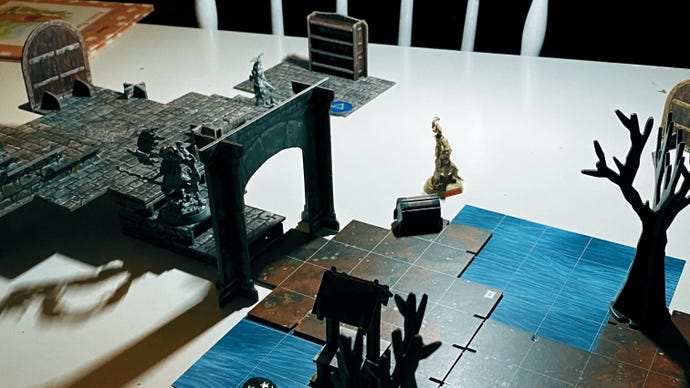
On the table, Descent: Legends of the Dark has a few tricks of its own – the flashiest being the “Ready” action that lets a player flip her cards over to the other side. This flipping over switches to different weapons and different powers, but also discards any bad tokens that have accumulated on those cards. Fatigue, a key element of every edition of Descent, builds up on your cards as you choose to push certain actions or activate special powers. That decision space, where you're trying to find the best time to flip a card to lose those fatigue tokens, would be a superb addition to any game of this type. Don't believe for one second that this is a board game where you're always staring at the computer screen. Most often, you'll be staring at your cards, asking yourself “How?” and “When?”
Can you tell that I like it yet?
But, man, it's expensive. And I should know – I bought it. The debate about this game is understandable. It's a very odd release. Many board gamers have rejected this game because, well – “It's not a board game. You don't even need any of the physical stuff. WHY NOT JUST PLAY A VIDEO GAME?”
But this isn't a computer game or a board game. It’s a friendly alliance of two worlds. The players at the table absolutely need the physical stuff. Not just because its how they actually play, but because it looks cool and feels great – and that's part of why we play these games. This is a celebration, this mad big thing. The plastic miniatures and the cardboard terrain and the roleplaying game atmosphere and the Fighting Fantasy unpredictability and the computer game's all-seeing eye – it's like a taste of everything from all of this stuff we love. If it doesn't feel exactly like a dungeon crawl board game, it's probably because this is a board game that has decided to sing to us about every kind of dungeon crawl game we've ever played, in all the ways we've ever played them.
Quite honestly, it's totally bloody romantic.

